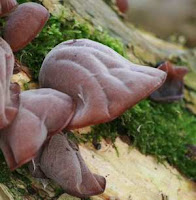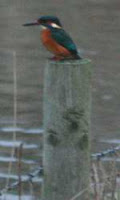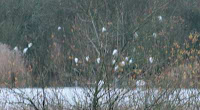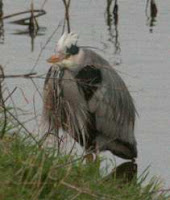 We've just had a good 11 day family holiday on Lewis, Outer Hebrides, staying for a week at Port Nis (Ness) near the Butt of Lewis, and then camping for the remainder at Cnip campsite near Valtos/Riof/Uig.
We've just had a good 11 day family holiday on Lewis, Outer Hebrides, staying for a week at Port Nis (Ness) near the Butt of Lewis, and then camping for the remainder at Cnip campsite near Valtos/Riof/Uig.
Our arrival was delayed as the Isle of Lewis ferry had suffered mechanical difficulties the previous day. CalMac got it fixed during the Saturday and we finally got away at 1:30am on the Sunday. We were slightly surprised to be filmed and waved at when we arrived at 4:30am, but this was the day of the first scheduled Sunday sailing from Stornoway; going by the TV news later, this seemed to be be widely welcomed with only a few dissenting souls.
 We had been on the look out for dolphins, propoises and whales all week, but only saw a few seals and possible hint of an otter. Apart that is, from the dead pilot whale calf washed up at Europie beach. On the way back from Stornoway to Ullapool, we were pleasantly surprised to find that there was a wildlife watching event on board, various helpers from SNH, MCS, RSPB etc looking for dolphins, propoises, whales and birds. A useful new SNH booklet was launched: Marine Life from Boat and Coast: a sightings guide for North-west Scotland. I saw Manx shearwater and Puffin, and a floating deceased cetacean. It would have been helpful if all the helpers had prominent badges on so we could identify them. We did not see any publicity for the event at Ullapool or Stornoway terminals, nor on the CalMac web site when we booked. It was good to chat to someone from the MCS about our plastic bag free campaigns.
We had been on the look out for dolphins, propoises and whales all week, but only saw a few seals and possible hint of an otter. Apart that is, from the dead pilot whale calf washed up at Europie beach. On the way back from Stornoway to Ullapool, we were pleasantly surprised to find that there was a wildlife watching event on board, various helpers from SNH, MCS, RSPB etc looking for dolphins, propoises, whales and birds. A useful new SNH booklet was launched: Marine Life from Boat and Coast: a sightings guide for North-west Scotland. I saw Manx shearwater and Puffin, and a floating deceased cetacean. It would have been helpful if all the helpers had prominent badges on so we could identify them. We did not see any publicity for the event at Ullapool or Stornoway terminals, nor on the CalMac web site when we booked. It was good to chat to someone from the MCS about our plastic bag free campaigns.
[Later: more suggestions for wildlife watching event. This is a great idea, even though it will be very hard to point things out to people as everything whizzes by very fast on a ferry - and things are usually at a distance. For the same reason, there might not be many occasions when it is possible to announce something to spot over the tannoy, except when near port. So, tell people to shout quickly to one of the observers if they spot something. Have a waterproof white board on deck to list all things spotted - this will act as a focal point. Talking to punters and having spare binoculars to help spot more common occurrences such as birds was good. Have wildlife posters up permanently inside would be good, eg the Lewis&Harris SNH poster. I'd suggest setting up watch stations on land on good view points with telescopes, eg run by volunteers, would be useful and would raise awareness (we didn't go to Tiumpan Head - what's there?) Ideally there should always be someone on longer summer ferry crossing (during day time) to spot wildlife, with permanent telescopes fixed onto the deck; I know that the ferry to North Spain over the Bay of Biscay is used for special whale watching trips, with special access to high decks. ]
 The gannets were amazing, visible from our cottage windows fishing at Port Nis and all along the coast. Plenty of arctic terns said hello - Caz here seemed to want to be attacked. The machair on the west coast was amazing. Elsewhere there was lots of horsetail around. Hearing my first corncrakes was great, as well as seeing a red throated diver family on an inland lochan, with one parent bringing in a fish. The hare bells at Cnip were the largest we've ever seen, three headed monsters.
The gannets were amazing, visible from our cottage windows fishing at Port Nis and all along the coast. Plenty of arctic terns said hello - Caz here seemed to want to be attacked. The machair on the west coast was amazing. Elsewhere there was lots of horsetail around. Hearing my first corncrakes was great, as well as seeing a red throated diver family on an inland lochan, with one parent bringing in a fish. The hare bells at Cnip were the largest we've ever seen, three headed monsters.
Birds: Gannet, Fulmar, Razorbill, Arctic Tern, Shag, Cormorant, Herring gull, Pied wagtail, Oyster catcher, Greylag goose, Arctic skua (pale+dark morphs), Black Guillemot, Guillemot, Kittiwake, Great black-backed gull, Rock dove, Blackbird, Great skua, Rock pipit, Black headed gull, House sparrow, Ringed plover, Raven, Lesser black-backed gull, Corncrake, Curlew, Starling, Buzzard, Mute swan, Eider, Dunlin, Shelduck, Redshank, Hooded crow, Sanderling, Meadow pipit, Wren, Golden plover, Snipe, Stonechat, Red throated diver, Common gull, Lapwing and Gray heron.
 Flowers: Bog asphodel, Sundew, Birds foot trefoil, Butterwort, Lousewort, Eyebright, Ragged robin, Meadow Cranesbill, Heath spotted-orchid, Horsetail, Bog pimpernel, Red clover, Ragwort, White clover, Field gentian, Sea mayweed, Tufted vetch, Sea sandwort, Thrift, Red bartsia, Brooklime, Self-heal, Crowberry, Marsh marigold, Yellow rattle, Milkwort, Wild carrot, Devil's bit scabious, Kidney vetch, Sea campion, Yarrow, Bistort, Silverweed, Primrose, Knapweed, Lesser meadow-rue, Spearwort, Bogbean, Scots lovage, Cross-leaved heath, Ling, Bell heather, Hare bell, Rose root, Hawksbeard, Stone crop and Moss campion.
Flowers: Bog asphodel, Sundew, Birds foot trefoil, Butterwort, Lousewort, Eyebright, Ragged robin, Meadow Cranesbill, Heath spotted-orchid, Horsetail, Bog pimpernel, Red clover, Ragwort, White clover, Field gentian, Sea mayweed, Tufted vetch, Sea sandwort, Thrift, Red bartsia, Brooklime, Self-heal, Crowberry, Marsh marigold, Yellow rattle, Milkwort, Wild carrot, Devil's bit scabious, Kidney vetch, Sea campion, Yarrow, Bistort, Silverweed, Primrose, Knapweed, Lesser meadow-rue, Spearwort, Bogbean, Scots lovage, Cross-leaved heath, Ling, Bell heather, Hare bell, Rose root, Hawksbeard, Stone crop and Moss campion.
There were probably more types of orchid, but we aren't experts on their id.
There was possibly another sort of gentian.
We also saw several butterflies (painted lady, tortoiseshell and meadow brown), moths (antler, dark arches, northern rustic) and lots of rabbits (several very black coloured).



















